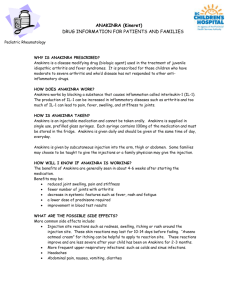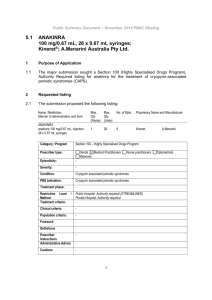Immunomodulatory adjunctive treatment optionsfor Ebola virus
advertisement
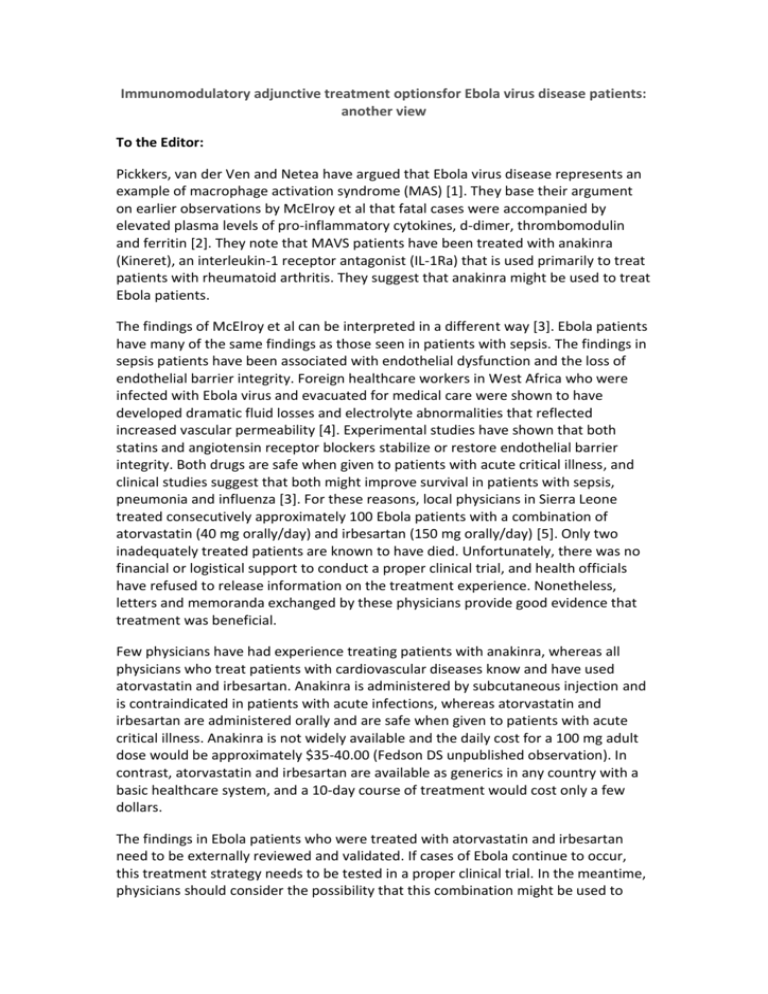
Immunomodulatory adjunctive treatment optionsfor Ebola virus disease patients: another view To the Editor: Pickkers, van der Ven and Netea have argued that Ebola virus disease represents an example of macrophage activation syndrome (MAS) [1]. They base their argument on earlier observations by McElroy et al that fatal cases were accompanied by elevated plasma levels of pro-inflammatory cytokines, d-dimer, thrombomodulin and ferritin [2]. They note that MAVS patients have been treated with anakinra (Kineret), an interleukin-1 receptor antagonist (IL-1Ra) that is used primarily to treat patients with rheumatoid arthritis. They suggest that anakinra might be used to treat Ebola patients. The findings of McElroy et al can be interpreted in a different way [3]. Ebola patients have many of the same findings as those seen in patients with sepsis. The findings in sepsis patients have been associated with endothelial dysfunction and the loss of endothelial barrier integrity. Foreign healthcare workers in West Africa who were infected with Ebola virus and evacuated for medical care were shown to have developed dramatic fluid losses and electrolyte abnormalities that reflected increased vascular permeability [4]. Experimental studies have shown that both statins and angiotensin receptor blockers stabilize or restore endothelial barrier integrity. Both drugs are safe when given to patients with acute critical illness, and clinical studies suggest that both might improve survival in patients with sepsis, pneumonia and influenza [3]. For these reasons, local physicians in Sierra Leone treated consecutively approximately 100 Ebola patients with a combination of atorvastatin (40 mg orally/day) and irbesartan (150 mg orally/day) [5]. Only two inadequately treated patients are known to have died. Unfortunately, there was no financial or logistical support to conduct a proper clinical trial, and health officials have refused to release information on the treatment experience. Nonetheless, letters and memoranda exchanged by these physicians provide good evidence that treatment was beneficial. Few physicians have had experience treating patients with anakinra, whereas all physicians who treat patients with cardiovascular diseases know and have used atorvastatin and irbesartan. Anakinra is administered by subcutaneous injection and is contraindicated in patients with acute infections, whereas atorvastatin and irbesartan are administered orally and are safe when given to patients with acute critical illness. Anakinra is not widely available and the daily cost for a 100 mg adult dose would be approximately $35-40.00 (Fedson DS unpublished observation). In contrast, atorvastatin and irbesartan are available as generics in any country with a basic healthcare system, and a 10-day course of treatment would cost only a few dollars. The findings in Ebola patients who were treated with atorvastatin and irbesartan need to be externally reviewed and validated. If cases of Ebola continue to occur, this treatment strategy needs to be tested in a proper clinical trial. In the meantime, physicians should consider the possibility that this combination might be used to treat patients with other forms of acute infectious disease, including pandemic influenza, in which failure to overcome endothelial dysfunction often leads to multiorgan failure and death. Words - 480 References 1. Pickkers P, van der Ven, Netea MG (2015). Immunomodulatory adjunctive treatment options for Ebola virus disease patients. Intensive Care Med. 41: 955 2. McElroy AK, Erickson BR, Flietstra TD, et al (2014). Ebola hemorrhagic fever: novel biomarker correlates of clinical outcome. J Infect Dis 210:558–566 3. Fedson DS (2015). A practical approach to treating patients with Ebola virus disease. J Infect Dis 211: 661-662 4. Lyon GM, Mehta AK, Varkey JB, et al (2015). Clinical care of two patients with Ebola virus disease in the United States. N Engl J Med 371: 2402-2409 5. Fedson DS, Rordam OM (2015). Treating Ebola patients: a “bottom up” approach using generic statins and angiotensin receptor blockers. Int J Infect Dis. To be published.




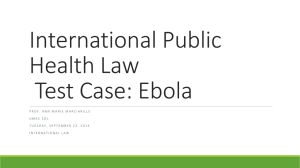

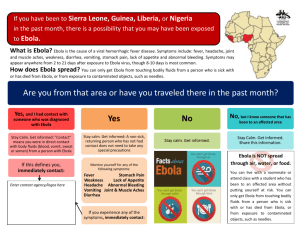
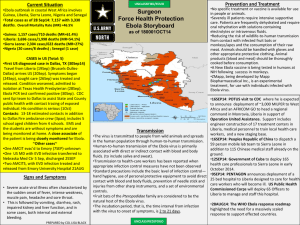
![FED.JACOB.OPAL.EBOLA.SHORT.[1.0]](http://s3.studylib.net/store/data/006654043_1-bf398f57ed1541f53bc39e64fdee62a4-300x300.png)
